Frames > More about framing > Framing behind glass
Fragile works
Acrylics or oil based colours are hardwearing materials. When applied to a canvas or panel, they are often varnished and do not require any specific type of protection. Pastels, charcoal, pencil drawings or watercolours on the other hand, that are applied to fragile supports such as silk, paper or cardboard, are placed under a protective sheet of glass. You need to choose the right type of glass, use only non-acidic materials, and render the frame airtight by using double edging.
• The first layer shuts in the subject between its support and glass.
• The second layer binds the protective back cover (the back) to the moulding of frame.
Within the frame, you often need to avoid direct contact between the glass and the subject. Some free space can be created between the subject and the sheet of glass by putting a small lath into the frame: English style framing (Fig 1) or by using a mount (Fig 3).
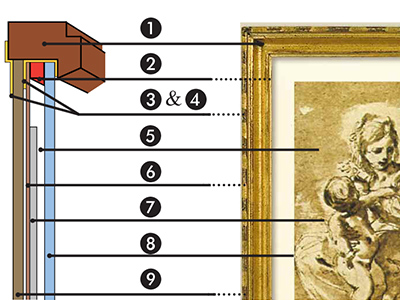
fig. 1 - English style framing
1 - Frame
2 - Lath
3 & 4 - Double edging
5 - Free Space
6 - Mounting board
7 - Artwork
8 - Glass
9 - Back cover
1 - Frame
2 - Lath
3 & 4 - Double edging
5 - Free Space
6 - Mounting board
7 - Artwork
8 - Glass
9 - Back cover
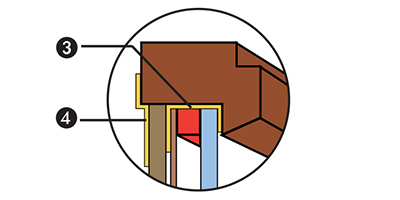
fig. 2 - Detail English style framing
• The first layer shuts in the subject between its support and glass.
• The second layer binds the protective back cover (the back) to the moulding of frame.
• The first layer shuts in the subject between its support and glass.
• The second layer binds the protective back cover (the back) to the moulding of frame.
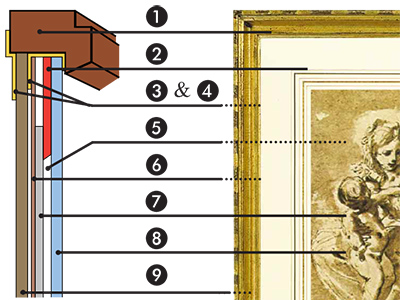
fig. 3 - Using a mount
1 - Frame
2 - Mount
3 & 4 - Double edging
5 - Free Space
6 - Mounting board
7 - Artwork
8 - Glass
9 - Back cover
1 - Frame
2 - Mount
3 & 4 - Double edging
5 - Free Space
6 - Mounting board
7 - Artwork
8 - Glass
9 - Back cover
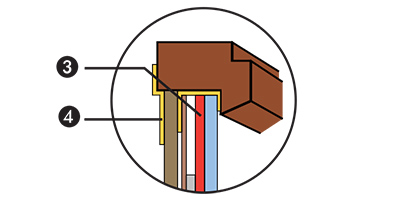
fig. 4 - Detail using a mount
• The first layer shuts in the subject between its support and glass.
• The second layer binds the protective back cover (the back) to the moulding of frame.
• The first layer shuts in the subject between its support and glass.
• The second layer binds the protective back cover (the back) to the moulding of frame.
Mounting the subject in its frame: three different techniques
Mounting the subject in its frame can be done using three different techniques.
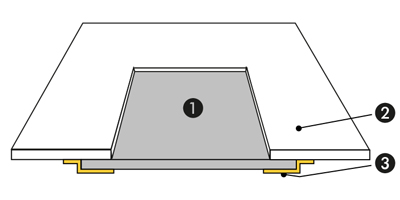
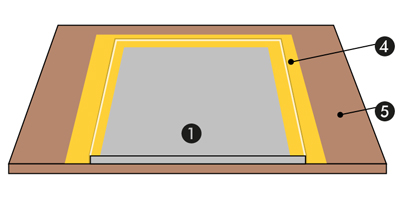
A. The Edging method
1 - Engraving
2 - Mount
3 - Edging the engraving to the mount
This technique involves stretching the subject in the frame, by attaching it to the mount or the mounting board using an adhesive strip that is free of wood fibres. State of the art knowledge on preserving cellulose fibres is applied when it comes to selecting the composition of the edging paper. (Test BAM – Az.3.3/8352/90. Before ageing: pH8.7 and after ageing : pH 8.4).
1 - Engraving
4 - Edging the engraving on the mounting board
5 - Mounting board
Edging ensures that the subject is correctly stretched and is lying perfectly flat. This is why edging is the technique most commonly used by traditional framers.
It should be noted that an edged subject should in principle remain taut as long as certain conditions are respected: maintain the work at a relative humidity level of 45-55% and at more or less 20° centigrade, and avoid any direct contact with heat or bright light. The only method that guarantees a permanently flat subject is gluing.
1 - Engraving
2 - Mount
3 - Edging the engraving to the mount
This technique involves stretching the subject in the frame, by attaching it to the mount or the mounting board using an adhesive strip that is free of wood fibres. State of the art knowledge on preserving cellulose fibres is applied when it comes to selecting the composition of the edging paper. (Test BAM – Az.3.3/8352/90. Before ageing: pH8.7 and after ageing : pH 8.4).
1 - Engraving
4 - Edging the engraving on the mounting board
5 - Mounting board
Edging ensures that the subject is correctly stretched and is lying perfectly flat. This is why edging is the technique most commonly used by traditional framers.
It should be noted that an edged subject should in principle remain taut as long as certain conditions are respected: maintain the work at a relative humidity level of 45-55% and at more or less 20° centigrade, and avoid any direct contact with heat or bright light. The only method that guarantees a permanently flat subject is gluing.
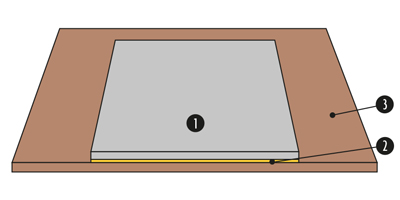
B. The marouflage (sticking) method
This technique involves fixing the subject to a suitable support using a special glue. This is, in principle, an irreversible technique: once you have stuck down the subject, you can no longer detach it from its support.
There are however, special glues that allow you to remove the subject from the support, if you so wish.
This mounting technique is generally only used to frame subjects that cannot be framed using the edging technique, for example, photographs, tracing paper or other subjects produced using synthetic materials. This is the only technique that allows you to obtain a correctly stretched and impeccably presented work. Restoration professionals only ever use glue that allows you to detach the subject from its support at a later date for works of art where the main concern is guaranteeing perfect preservation.
This technique involves fixing the subject to a suitable support using a special glue. This is, in principle, an irreversible technique: once you have stuck down the subject, you can no longer detach it from its support.
There are however, special glues that allow you to remove the subject from the support, if you so wish.
This mounting technique is generally only used to frame subjects that cannot be framed using the edging technique, for example, photographs, tracing paper or other subjects produced using synthetic materials. This is the only technique that allows you to obtain a correctly stretched and impeccably presented work. Restoration professionals only ever use glue that allows you to detach the subject from its support at a later date for works of art where the main concern is guaranteeing perfect preservation.
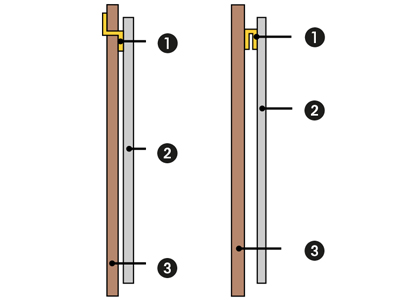
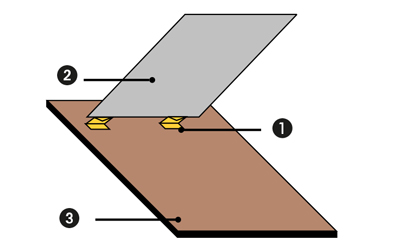
C. Hinge mounting
This method’s main purpose is to guarantee perfect, extremely long- term preservation of fragile works of art. The subject is not fixed into the frame but is simply placed inside it. It is held in place by narrow strips of gummed paper (fig 4) folded or slid into notches in the cardboard.
1 - Strips of gummed paper are folded or slid into notches on the mounting board.
2 - Engraving
3 - Mounting board
All you need to do to detach the work of art is to cut the gummed paper strips which can be easily removed without leaving any marks behind.
This method is used for very fragile or extremely valuable subjects but is not pleasing to the eye (the subject tends to warp in the frame).
1 - Strips of gummed paper are folded or slid into notches on the mounting board.
2 - Engraving
3 - Mounting board
This method’s main purpose is to guarantee perfect, extremely long- term preservation of fragile works of art. The subject is not fixed into the frame but is simply placed inside it. It is held in place by narrow strips of gummed paper (fig 4) folded or slid into notches in the cardboard.
1 - Strips of gummed paper are folded or slid into notches on the mounting board.
2 - Engraving
3 - Mounting board
All you need to do to detach the work of art is to cut the gummed paper strips which can be easily removed without leaving any marks behind.
This method is used for very fragile or extremely valuable subjects but is not pleasing to the eye (the subject tends to warp in the frame).
1 - Strips of gummed paper are folded or slid into notches on the mounting board.
2 - Engraving
3 - Mounting board



